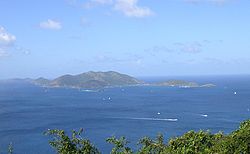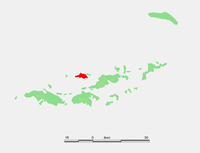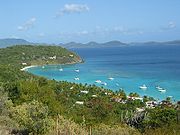
Jost Van Dyke
Encyclopedia


British Virgin Islands
The Virgin Islands, often called the British Virgin Islands , is a British overseas territory and overseas territory of the European Union, located in the Caribbean to the east of Puerto Rico. The islands make up part of the Virgin Islands archipelago, the remaining islands constituting the U.S...
, the northern portion of the archipelago of the Virgin Islands
Virgin Islands
The Virgin Islands are the western island group of the Leeward Islands, which are the northern part of the Lesser Antilles, which form the border between the Caribbean Sea and the Atlantic Ocean...
, located in the Atlantic Ocean
Atlantic Ocean
The Atlantic Ocean is the second-largest of the world's oceanic divisions. With a total area of about , it covers approximately 20% of the Earth's surface and about 26% of its water surface area...
and Caribbean Sea
Caribbean Sea
The Caribbean Sea is a sea of the Atlantic Ocean located in the tropics of the Western hemisphere. It is bounded by Mexico and Central America to the west and southwest, to the north by the Greater Antilles, and to the east by the Lesser Antilles....
. Jost Van Dyke lies about 8 km to the northwest of Tortola
Tortola
Tortola is the largest and most populated of the British Virgin Islands, a group of islands that form part of the archipelago of the Virgin Islands. Local tradition recounts that Christopher Columbus named it Tortola, meaning "land of the Turtle Dove". Columbus named the island Santa Ana...
and 8 km to the north of Saint John. Little Jost Van Dyke
Little Jost Van Dyke
Little Jost Van Dyke is one of the British Virgin Islands. It is a small island on the east end of the island of Jost Van Dyke. Like Jost Van Dyke, it takes its name from the Dutch privateer Joost van Dyk...
lies off its eastern end.
Like many of the neighboring islands, it is volcanic
Volcano
2. Bedrock3. Conduit 4. Base5. Sill6. Dike7. Layers of ash emitted by the volcano8. Flank| 9. Layers of lava emitted by the volcano10. Throat11. Parasitic cone12. Lava flow13. Vent14. Crater15...
in origin and mountainous. The highest point on the island is Roach Hill at 321 meters (1054 ft).
History
Despite rumours that the island's name comes from that of a 17th century Dutch privateer, Joost van DykJoost van Dyk
Joost van Dyk was a Dutch privateer who was one of the earliest European settlers in the British Virgin Islands in the seventeenth century, and established the first permanent settlements within the Territory...
, who used its harbours as a hideout, there is no factual evidence supporting this claim. Just who Jost Van Dyke's namesake is remains a mystery. John C. Lettsome
John C. Lettsome
Dr. John Coakley Lettsome was an English physician and philanthropist born on Little Jost Van Dyke in the British Virgin Islands. He was born into one of the early Quaker settlements in the territory, and grew up to be an abolitionist...
(of Little Jost Van Dyke), founder of the Medical Society of London
Medical Society of London
The Medical Society of London is one of the oldest surviving medical societies in the United Kingdom ....
is Jost Van Dyke's most noteworthy resident.
Although the English captured the BVI in 1672, it seems that Jost Van Dyke was mostly ignored until the mid-18th century. A map drawn of the BVI in 1717 by Captain John Walton does not depict either Jost Van Dyke or Little Jost Van Dyke.
The remains of a sugar works on the ridge above Great Harbour provide archaeological evidence that some sugar cane was under cultivation and processed, though probably not in any great quantity.
In 1815, 140 acre (0.5665604 km²) were under cotton cultivation, producing 21,000 pounds annually. There was a population of 428 (25 whites, 32 free persons of colour and 371 slaves). By 1825, cotton production decreased to 17,000 pounds, while the population increased to 506 (34 whites, 76 free persons of colour and 397 slaves).
Similar to other islands in the region, JVD and the BVI saw gradual and irreversible economic decline throughout the 18th century. Curiously though, the population of Jost Van Dyke continued to increase (probably due to the freedom of travel enjoyed by the former slave population after Emancipation in the BVI in 1838). Thereafter, many BVI islanders regularly sought work at the Royal Mail Steam Packet Company's coaling whaves in St. Thomas, (today- United States Virgin Islands). By 1853, Dookhan (1975) attributes a population of 1,235 residents on Jost Van Dyke, 196 of whom died of a cholera outbreak in that same year.
From the Emancipation Era forward, the community of Jost Van Dyke subsisted mainly on small scale fishing and subsistence agriculture. Charcoal making was a practice that began during the plantation era, when strong fires were vital for sugar and rum production, and charcoal making emerged as a primary industry for the BVI during the Post-Emancipation years. Between the 1920s and 1960s, an estimated 20,000 tons of charcoal were exported from the BVI to the US Virgin Islands. (1998. Penn-Moll, Verna,Coals of Fire: The Development of the Caribbean Fireplace Technology with Traditional Customs, Myths and Sayings.)
According to island residents, on JVD, people would work collectively to build charcoal pits, a practice that occasionally continues to this day. The pits were often a social gathering place, women might use the heat of the fire to bake bread or roast breadfruit while the men might play dominoes around the pit.
Maritime resources were also extremely important historically to the people of Jost Van Dyke, and the island has emerged as a fishing village. The desire for trade and social interaction with nearby islands stimulated the development of seafaring skills. Sailing, fishing, rowing and boat construction flourished. Small, locally constructed sailing vessels the "Tortola Boat" flourished in the BVI until about the 1960s when they were replaced with motorized craft.
Demographics and tourism
A few hundred people live on Jost Van Dyke. (The recorded population in 1991 was 140; however, the population increased in the late 1990s with the advent of electricity and paved roads.) As of 2008, the population recorded was 297 (though many residents argue that the government-derived population figure is too high and believe that citizens who actually live in St. Thomas may be included in that census). The island has a young population with nearly one-half (46%) of residents under the age of 35 and almost 70% under the age of 50.Jost Van Dyke receives numerous visitors. The island is accessible by private boat
Boat
A boat is a watercraft of any size designed to float or plane, to provide passage across water. Usually this water will be inland or in protected coastal areas. However, boats such as the whaleboat were designed to be operated from a ship in an offshore environment. In naval terms, a boat is a...
s and ferry
Ferry
A ferry is a form of transportation, usually a boat, but sometimes a ship, used to carry primarily passengers, and sometimes vehicles and cargo as well, across a body of water. Most ferries operate on regular, frequent, return services...
service from Tortola and Saint Thomas (via Saint John). Dolphin Water Taxi from Cruz Bay St. John, US Virgin Islands is one way of visiting Jost Van Dyke.
The most frequent destination is Great Harbor (or Great Harbour). The beach strip around the harbour is lined with small bars and restaurants. Since the late 1960s, Foxy's Bar in Great Harbor has been a popular stop for Caribbean
Caribbean
The Caribbean is a crescent-shaped group of islands more than 2,000 miles long separating the Gulf of Mexico and the Caribbean Sea, to the west and south, from the Atlantic Ocean, to the east and north...
boaters. Foxy's and the other bars in Great Harbor now host a modest crowd year-round and are filled with thousands of partiers on New Year's Eve
New Year's Eve
New Year's Eve is observed annually on December 31, the final day of any given year in the Gregorian calendar. In modern societies, New Year's Eve is often celebrated at social gatherings, during which participants dance, eat, consume alcoholic beverages, and watch or light fireworks to mark the...
(locally known as "Old Year's Night").
Great Harbour is one of the busiest ports in the BVI: in 2008, nearly 7,000 boats cleared through the island's port. Today, tourism, and particularly yachting tourism is the mainstay of the economy.

Painkiller (cocktail)
A Painkiller is a rum cocktail. A painkiller is traditionally made by frothing a mixture of dark rum, orange juice, pineapple juice, sweetened coconut cream, and shaved ice, and topping with nutmeg....
. The Soggy Dollar bar is appropriately named because when built there was neither road nor dock. (There is now a road from Great Harbour, but still no dock). To reach the beach where the bar is located, it is a common practice for boaters to anchor off the beach, swim to shore, and pay for their drinks with wet money.
The country music video for Kenny Chesney
Kenny Chesney
Kenneth "Kenny" Arnold Chesney is an American country music singer and songwriter. Chesney has recorded 15 albums, 14 of which have been certified gold or higher by the RIAA. He has also produced more than 30 Top Ten singles on the U.S...
's 2002 recording, No Shoes, No Shirt, No Problems (song)
No Shoes, No Shirt, No Problems (song)
"No Shoes, No Shirt, No Problems" is a song written by Casey Beathard and recorded by American country music singer Kenny Chesney. It was released as the fifth and final single from his 2002 album of the same name...
, was filmed on and around Jost Van Dyke. Included in the video were several scenes at One Love Bar and Ivan's Stress-Free Bar where it is common for patrons to mix their own drinks, and leave their payment in the register. Chesney also references Jost Van Dyke in his song, Somewhere in The Sun, from his album Be as You Are (Songs from an Old Blue Chair)
Be as You Are (Songs from an Old Blue Chair)
- Chart performance :- Certifications :...
.
Education
The British Virgin Islands operates several government schools.Jost Van Dyke residents are served by Jost Van Dyke Primary School which offers both Primary and Secondary education. At present, (2011) after students graduate from primary school they attend secondary (High School) for two years on Jost Van Dyke. After completing two years of high school on Jost Van Dyke, students travels daily from Monday to Friday to the main island of Tortola to attend the Elmore Stoutt High School. Students must catch the 7:00am ferry (NEW HORIZON FERRY SERVICE) and returns to Jost Van Dyke on the 4:00pm ferry.

